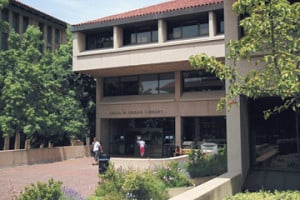
A 2008 article in the Times Higher Education supplement stated, “School libraries are suffering, and even closing, as resources are cut, staff ‘redeployed’ and the Internet deemed more important to learning than printed matter.”
Such a trend, however, has not materialized at Stanford, according to Andrew Herkovic, director of communications and development for the Stanford Libraries.
“[The idea of] ‘the end of the library’ turns out to be completely untrue at Stanford,” Herkovic said. “We have not seen any net decrease [in users] over the years in each of the libraries, and I don’t think we will.”
Of the 20 libraries at Stanford, Green Library is the most widely used, especially by undergraduates. According to Chris Bourg, assistant university librarian, Green has averaged over 600,000 visitors a year over the last five years.
According to Hoover Library librarian Paul Thomas, most undergraduates tend to use Green Library. He added that “fewer students use our collections because [they’re] more geared toward scholars and graduate students.”
Nevertheless, according to Nick Siekierski, exhibits and outreach co-coordinator at the Hoover Institution, the Hoover Library does not lack undergraduate visitors. He cites the presentations and tours that he organizes for undergraduates, particularly for primary source materials used in classes in the Program in Writing and Rhetoric (PWR) and Structured Liberal Education (SLE).
The libraries perform different functions on campus. Hoover Library, according to both Thomas and Siekierski, is used primarily for primary source research, while Green and Meyer Libraries have more multifunctional roles.
Herkovic pointed out that many students do work at Green Library and Meyer Library that they could also do in their dorm rooms or anywhere else.
“[Students] choose to come to the library because it’s the conducive place, it’s the fitting setting for doing their research and study and secondary reading,” he said.
He held that the library provides a certain atmosphere rather than just being a repository of books.
“People do everything, most of the human functions with the exception of eating [in the library]…there’s study and homework and sleep and love,” he said.
Not surprisingly, the Stanford librarians report that the number of students in the libraries increases tremendously during the last few weeks of the quarter.
“It ebbs and flows, towards the end of each term, we tend to see more students; towards the end of the year, we tend to see more students,” Thomas said.
Although the possible demise of the library has sometimes been closely linked to the increase in the digital availability of information, the Stanford librarians disagree that libraries may become obsolete.
“I think it’s a complementary thing,” Siekierski said. “You still need librarians and archivists and specialists that really know their way around the information to guide people to those places, so I think if anything having our stuff available online leads people to come here.”
Herkovic noted the increasing role of the library on the web.
“The libraries spend many millions of dollars a year paying for subscriptions and online services,” Herkovic said. “In that sense, we become more and more important to how people get and use information but we may be less visible doing it.”
“The mediation that libraries have always provided is still very much at play in a different form,” he added.
-Elena Ayala-Hurtado